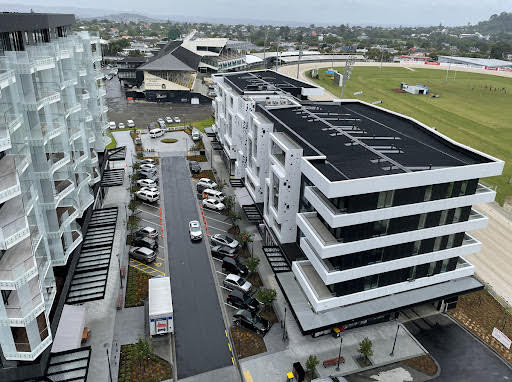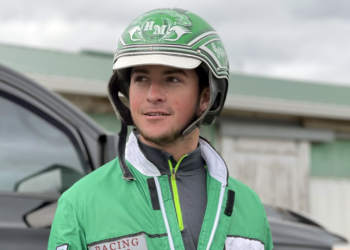The Auckland Trotting Club will continue legal action to try to recover some of the $100 million lost in the building of its apartment complex.
But when the harness racing club finally reveals details of its long-running dispute with construction company Canam at next Wednesday’s annual general meeting, president Rod Croon will be assuring members it will not be pouring millions more into the bid.
The club’s accounts show more than $6 million has been spent on legal fees since it dismissed Canam in July, 2018, after a slew of problems, with many believing the cost has been even higher.

And even though Canam is now in liquidation, the club has indicated it plans to pursue the company’s directors personally, along with quantity surveyors, project managers, engineers and even its solicitors.
The final wash-up cost the ATC incurred as a result of the Canam debacle has just been certified by the club’s contract engineer and while the exact figure cannot be revealed before it is lodged with the arbitrator and the High Court it runs into tens upon tens of millions.
In August, three years after Canam sued the ATC, the arbitrator made a first interim award but it did not favour Canam as that company’s liquidator misleadingly quoted in its first report using information provided solely by directors Loukas Petrou and Stephen Jones.
Canam was awarded $933,283 mainly in relation to extensions of time and contract variations but it failed in 15 of the 18 clauses and a far bigger sum, $2,496,108, was awarded to the trotting club, with rights being reserved for future determination of the full amount after the final costs were known.
Canam told the liquidator while it was awarded “a large sum” it could not collect until a counter claim by the club was heard and it could not justify spending money it did not have with the result uncertain.
The ATC tells a far different story. Canam had failed to give the club a parent company guarantee from Canam Group Ltd. as required in the contract and when ordered to by the arbitrator in a second award it immediately wound up the company, hiding under the corporate veil.
The club claims its Christchurch lawyers Lane Neave should have picked up the key omission and that’s why it is included on its list of targets, proceedings having already been filed in the High Court.
The ATC will promise members it will not be spending another $6 million on the case but will approach it on a contingency basis. While there will be some basic costs, substantive fees will only be payable if there is a successful result.
The ATC denies it offered Canam money to drop its case against the club, as claimed in the liquidator’s report.
“We offered to settle both before and part way through the arbitration. We said let’s walk away, everybody bears their own costs,” an ATC source said.
“The club had its back against the wall. If it didn’t defend, Canam would have got judgement and taken all its assets.”
Fears expressed at original meeting
Members at next week’s meeting are sure to remind the ATC board of the fears expressed about the numerous pitfalls of property development at the original special general meeting in November, 2014 when it was announced the club would run the project itself, rather than take a smaller guaranteed profit by paying someone else to build the apartments.
But the then president Kerry Hoggard, on whose property expertise the board was relying, died in October, 2015, less than two months after the first sod was turned.
From the outset Canam encountered problems with the foundations. Unstable volcanic rock forced the club’s engineers Engenium to fill cavernous holes with concrete and to use piles instead of concrete bases under each column of steel, at an extra cost of more than $5 million, putting the build a year behind schedule.
Meanwhile the Australian company Ganellen, hired to construct two more apartment buildings, had even worse problems with its foundations.
In April, 2018, the Auckland City Council ordered a halt to all work on both projects, citing issues with the steel, bought from China, and breaches of the building consent through lack of inspections. It took three months to resolve the issue.
While the parties bickered about who was responsible, questions arose on why the club had engaged Engenium, whose engineer Alan Reay designed the Christchurch CTV building that collapsed during the February, 2011 earthquake, killing 115 people. Reay escaped charges but was later criticised by a Royal Commission.
The trotting club’s steel was supplied by Reay’s long-time associate property developer Bert Govan’s Challenge Steel which later went into liquidation owing $10 million.
Unhappy with Canam’s progress on the job, the ATC terminated Canam’s contract in July, 2018, and appointed another Auckland company, CMP Construction, spending many millions correcting Canam’s mess.
Another major disruption that cost millions and months to fix came when the wrong cladding was put up on the buildings and had to be pulled down and replaced.
Ganellen also took a case against the ATC, believed to be for more than $13 million for lost time and variations to its contract. Despite repeated assurances from its legal advisors that the club would win, the judgements came back in favour of Ganellen and the club ended up paying out an undisclosed amount in a mediated settlement.
Insiders believe much of the legal fee haemhorraging could have been avoided had the club sat down and discussed the issues with its contractors, rather than pointed guns at each other.
ATC directors served with legal papers
Unknown to its members, Ganellen served every director on the board with legal papers, saying they could be personally liable for acting unreasonably in not trying to work out a solution.
But, according to one inside source, perhaps the most costly decision the board made in its naievity over property development, was not taking the chance to mitigate its losses when various sunset clauses were activated after the project fell years behind schedule.
With all the delays and with costs of labour and materials rising, most savvy property developers would have revised the price of the apartments to more like market level. The units had already risen in value by 20 to 30% over the years so investors would not have suffered.
President Bruce Carter, however, was determined to honour the club’s word to buyers, passing on the chance to recoup tens of millions of dollars, the suggestion also that he feared people might choose to walk away and a glut of apartments would come up for resale.
Ultimately, it appears the turnaround on a project initially projected to earn the club $48 million, came down to a lack of construction expertise on the board, though many sitting round the table were reportedly often never privy to dispute details, handled by a dominant president and CEO.
The project was developed and managed by CEO Dominique Dowding, who had no experience in property development when she came to the club in 2012 after seven years as the sales, marketing, events and entertainment manager at the Christchurch Town Hall.
Dowding, who was also responsible for the investment, funding and all legal and financial reporting, won the Auckland Property Council’s inaugural Women in Property Award in 2016 for her ongoing leadership on the significant urban village.
A citation at the time said: “As chief executive, Ms Dowding has led the board’s strategic turn-around of the 126-year-old iconic Auckland Trotting Club to put it on a more commercial footing, ensuring its long-term financial sustainability and the survival of harness racing in the northern region.
Dowding left the club in March, 2019.
The 246 apartment development, which realised $295 million in sales, was finally finished this year, four years after its scheduled completion.
By Barry Lichter

 USA
USA Canada
Canada Australia
Australia New Zealand
New Zealand Europe
Europe UK / IRE
UK / IRE



